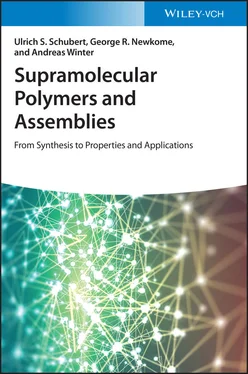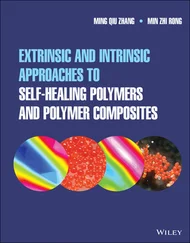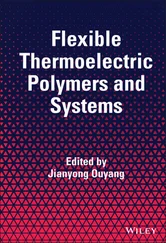A catalogue record for this book is available from the British Library.
The Deutsche Nationalbibliothek lists this publication in the Deutsche Nationalbibliografie; detailed bibliographic data are available on the Internet at < http://dnb.d-nb.de>.
© 2021 WILEY‐VCH GmbH, Boschstr. 12, 69469 Weinheim, Germany.
All rights reserved (including those of translation into other languages). No part of this book may be reproduced in any form – by photoprinting, microfilm, or any other means – nor transmitted or translated into a machine language without written permission from the publishers. Registered names, trademarks, etc. used in this book, even when not specifically marked as such, are not to be considered unprotected by law.
There is a long history of the use of both naturally occurring polymers and synthetic polymers culminating in our current deep understanding of supramolecular polymers. In the 1500s, British explorers discovered that Mayan children were playing with rubber balls made from local trees and, 150 years ago, the first synthetic polymer was made by Wesley Hyatt. He treated cellulose with camphor to create a synthetic ivory to meet the needs of the then rapidly growing billiard enterprise. This year, synthetic polymer chemistry celebrates its 100th birthday, marked by when Hermann Staudinger published his then highly controversial proposal that polymers are indeed long chains, which are formed from repeating molecular units by covalent bonds. Throughout the last century, polymer chemistry has evolved tremendously not only with respect to the design and synthesis of tailor‐made architectures but also concerning the wide range of utilitarian applications to be found in our daily lives. By the 1970s, the use of polymer/plastic surpassed that of steel, aluminum, and copper – combined.
In the 1960s, supramolecular polymers were created in which two or more ions or molecules are held together by non‐covalent interactions, such as ionic/Coulombic, hydrogen‐bonding, and π–π‐stacking interactions as well as metal‐to‐ligand coordination. A wide, diverse group of host–guest (inclusion) complexes was named in this context. Despite their chemically, highly different nature, they offer common characteristics, such as the unique ability to assemble linear polymer chains due to the mostly high directionality of these interactions and, even more importantly, their reversibility of binding. Thus, when incorporated into a polymer backbone, materials are obtained that exhibit properties that cannot be realized by traditional, i.e. covalent polymers.
Today, the fundamental theories that govern supramolecular polymerization reactions are well understood using a broad range of traditional and new analytical techniques, allowing their in‐depth characterization both in solution and in the solid state. This overview of the different types of supramolecular polymers is organized according to the non‐covalent interactions from which they have been assembled. In each case, the fundamental aspects as well as examples of supramolecular polymers with respect to their synthesis, properties, and potential applications are summarized. We have attempted to cover each field as detailed as possible in order to assist future researchers in this rapidly expanding arena. Future research on supramolecular polymers will continue to develop and thus, in part, replace traditional historic polymeric materials. It will be important to also make forthcoming materials more biodegradable, lighter, safer, and yet still inexpensive. Hopefully, this overview will help researchers open new pathways to supramolecular systems.
| 18C6 |
18‐crown‐6 |
| A |
adenine orabsorbance |
| A 2 |
second virial coefficient |
| acac |
acetoacetate |
| ACQ |
aggregation‐caused quenching |
| AFM |
atomic force microscopy |
| AF4 |
asymmetric flow field flow fractionation |
| AIE |
aggregation‐induced emission |
| Alq3 |
tris(8‐hydroxyquinolinato)aluminium |
| ATP |
adenosine triphosphate |
| ATRP |
atom transfer radical polymerization |
| AUC |
analytical ultracentrifugation |
| bdt |
1,2‐benzenedithiolate |
| bFGF |
basic fibroblast growth factor |
| Bn |
benzyl |
| BODIPY |
boron‐dipyrromethene |
| BMP32C10 |
bis( m ‐phenylene)‐32‐crown‐10 |
| BPP34C10 |
bis( p ‐phenylene)‐34‐crown‐10 |
| BSA |
Bovine serum albumin |
| B21C7 |
benzo‐21‐crown‐7 |
| cac |
critical aggregation concentration |
| CB[ n ] |
cucurbit[ n ]uril; n = number of glycuril units |
| CD |
circular dichroism orcyclodextrin |
| CDSA |
crystallization‐driven self‐assembly |
| c eff |
effective concentration |
| Ce6 |
chlorin‐e6 |
| cgc |
critical gelation concentration |
| Ch + |
cycloheptatrienyl cation |
| ChE |
cholinesterase |
| CIA |
calixarene‐induced aggregation |
| CIE |
commission Internationale de l′Éclairage |
| CLSM |
confocal laser scanning microscopy |
| cmc |
critical micellar concentration |
| CNT |
carbon nanotube |
| CONASH |
coordination nanosheet |
| cpc |
critical polymerization concentration |
| CPK (models) |
3D molecular models |
| CS |
cold spray |
| CT |
charge transfer |
| CuCAAC |
Cu(I)‐catalyzed azide‐to‐alkyne cycloaddition |
| CV |
cyclic voltammetry |
| CVD |
chemical vapor deposition |
| DABCO |
1,4‐diazabicyclo[2.2.2]octane |
| DBU |
1,8‐diazabicyclo[5.4.0]undec‐7‐ene |
| DB24C8 |
Dibenzo‐24‐crown‐8 |
| DCC |
dynamic covalent chemistry |
| DEB |
diethyl barbiturate |
| DHP |
dihexyldecylphosphonate |
| DLS |
dynamic light scattering |
| DMAc |
dimethyl acetamide |
| DMF |
dimethyl formamide |
| DMSO |
dimethylsulfoxide |
| DNA |
deoxyribonucleic acid |
| DP |
degree of polymerization |
| DPP |
diphenylphenanthrene ordiketopyrrolopyrrole |
| DOSY |
diffusion‐ordered (NMR) spectroscopy |
| DOX |
doxorubicin |
| DQ |
( 1H) double quantum |
| DSC |
differential scanning calorimetry |
| Ð |
dispersity |
| E |
molar absorptivity |
| EDTA |
ethylenediamine tetraacetic acid |
| EPR |
electron paramagnetic resonance |
| EM |
effective molarity |
| ESI |
electrospray ionization |
| exTTF |
π‐extended tetrathiafulvalene |
| f |
packing factor |
| f H |
host molar fraction |
| FAB |
fast atom bombardment |
| Fc + |
ferrocenium cation |
| FDA |
U.S. Food and Drug Administration |
| FE |
field emission |
| FEB |
frequency‐domain electric birefringence |
| FF |
fill factor |
| FRET |
Föster‐type resonance energy transfer |
| FRP |
free‐radical polymerization |
| FTICR |
Fourier‐transform ion cyclotron resonance |
| FT‐IR |
Fourier‐transform infrared |
| GAL1 |
Galectin‐1 |
| gMS 2 |
gradient tandem MS 2 |
| Δ G 0 |
Gibbs free energy |
| HBC |
hexabenzocoronene |
| HDPE |
high‐density polyethylene |
| HEEDTA |
hydroxyethylethylenediaminetriacetic acid |
| HER |
hydrogen‐evolution reaction |
| HETPHEN |
heteroleptic phenanthroline |
| HFIP |
1,1,1,3,3,3‐hexafluoroisopropanol |
| HG |
host–guest complex |
| HPLC |
high‐performance liquid chromatography |
| HOMO |
highest occupied molecular orbital |
| HOPG |
highly‐ordered pyrolytic graphite |
| HSAB |
hard and soft acid and bases |
| HSCT |
host‐stabilized charge transfer |
| I |
scattered intensity |
| IDP |
isodesmic supramolecular polymerization |
| IM |
ion mobility |
| IR |
infrared |
| ISA |
ionic self‐assembly |
| ITC |
isothermal titration calorimetry |
| ITO |
indium tin oxide |
| K a |
association constant |
| K d |
dissociation constant |
| L |
persistence length of polymer |
| LB |
Langmuir–Blodgett |
| LC |
liquid crystal (or liquid crystalline) |
| LCD |
liquid crystal display |
| LCST |
lower critical solution temperature |
| LED |
light‐emitting diode |
| LSI |
liquid secondary ion |
| LT |
low temperature |
| LUMO |
lowest unoccupied molecular orbital |
| M n |
molar mass |
| M w |
molecular weight |
| MALDI |
matrix‐assisted laser desorption/ionization |
| MALS |
multi‐angle light scattering |
| MAS |
magic angle spinning |
| Mb |
myglobin |
| MDI |
methylenediphenyl‐4,4′‐diisocyanate |
| mebip |
2,6‐bis(1‐methyl‐1H‐benzo[ d ]imidazole‐2‐yl)pyridine |
| MFP |
molecular force probe |
| MLCT |
metal‐to‐ligand charge transfer |
| MMLCT |
metal‐metal‐to‐ligand charge transfer |
| MM2 |
molecular modeling 2 |
| MPEG |
PEM monomethyl ether |
| MOF |
metal‐organic frameworks |
| MS |
mass spectrometry |
| MTZ |
mitoxantrone |
| MV 2+ |
methylviologen (i.e. N , N′ ‐Dimethyl‐4,4′‐bipyridinium cation) |
| NAND |
“NAND” logic gate |
| Napy |
2,7‐diamido‐1,8‐naphthyridine |
| NBI |
naphthalene bisimide |
| NEP |
nucleation–elongation polymerization |
| NHC |
N ‐heterocyclic carbene |
| NMP |
nitroxide‐mediated polymerization or N ‐methylpyrrolidone |
| NMR |
nuclear magnetic resonance |
| Np |
naphthalene |
| ODT |
order–disorder transition |
| OEG |
oligo(ethylene glycol) |
| OF |
oligofluorene |
| OFET |
organic field‐effect transistor |
| OPE |
oligo(phenylene‐ethynylene) |
| OPV |
oligo(phenylene‐vinylene) |
| oxSWCNT |
oxidized single‐walled carbon nanotubes |
| P |
form factor |
| P |
probability of binding |
| PAA |
poly(acrylic acid) |
| PAC |
polyelectrolyte–amphiphile complex |
| PAH |
polycyclic aromatic hydrocarbon |
| PANI |
polyaniline |
| PBD |
polybutadiene |
| PBH |
poly[( R )‐3‐hydroxybutryic acid] |
| PBI |
perylene bisimide |
| PBS |
poly(butylene succinate) |
| PC |
polycarbonate |
| PCBA |
phenyl(C 61)butyric acid |
| PCBM |
phenyl[6.6]‐C 61‐butyric acid methyl ester |
| PCE |
power conversion efficiency |
| PCl |
poly(ε‐caprolactone) |
| PDMA |
poly( N , N ‐dimethylacrylamide) |
| PDMAEMA |
poly(dimethylaminoethyl methacrylate) |
| PDMS |
poly(dimethylsiloxane) |
| PDT |
photodynamic therapy |
| PE |
polyethylene |
| PEB |
poly(ethylene‐ co ‐butylene) |
| PEC |
polyelectrolyte complex |
| PEG |
poly(ethylene glycol) |
| PEI |
polyethyleneimine |
| PEK |
poly(etherketone) |
| PEP |
poly(ethylene‐ co ‐propylene) |
| PET |
poly(ethylene terephthalate) |
| PFGSE |
pulse field gradient spin‐echo |
| PFSD |
poly(ferrocenyldimethylsilane) |
| PI |
polyisoprene |
| PIB |
polyisobutylene |
| PIPS |
polymerization‐induced phase separation |
| PLA |
poly(D,L‐lactide) |
| PLED |
polymer‐based light‐emitting diode |
| PMA |
poly(methyl acrylate) |
| PMMA |
poly(methyl methacrylate) |
| PMVE |
poly(vinylmethyl ether) |
| PNIPAM |
poly( N ‐isopropyl acrylamide) |
| POM |
polarized optical microscopy |
| PP |
polypropylene |
| PPA |
polyphenylacetylene |
| PPE |
poly(phenylene‐ethynylene) |
| PPI |
poly(propylene imine) |
| PPO |
poly(propylene oxide) |
| PS |
polystyrene orphotosensitizer |
| PSS |
poly(styrene sulfonate) |
| PT |
polythiophene |
| PTBA |
poly(tert‐butyl acrylate) |
| PTFMS |
poly( p ‐trifluoromethylstyrene) |
| PTHF |
poly(tetrahydrofuran) |
| Pybox |
2,6‐bis(oxazol‐2‐yl)pyridine |
| P2VP |
poly(2‐vinylpyridine) |
| P3HT |
poly(3‐hexylthiophene) |
| P3MT |
poly(3‐methylthiophene) |
| P3OM |
poly(oxotrimethylene) |
| P4HB |
poly(4‐hydroxybutyrate) |
| P4VP |
poly(4‐vinylpyridine) |
| Q |
heat orscattering vector |
| QTOF |
quadrupole time of flight |
| R g |
radius of gyration |
| R h |
hydrodynamic radius |
| RAFT |
reversible addition–fragmentation chain transfer |
| ROMP |
ring‐opening metathesis polymerization |
| ROP |
ring‐opening polymerizations |
| SAM |
self‐assembled monolayer |
| SANS |
small‐angle neutron scattering |
| Sav |
streptavidin |
| SAXS |
small‐angle X‐ray scattering |
| SCNP |
single‐chain nanoparticle |
| SEC |
size‐exclusion chromatography |
| SEM |
scanning electron microscopy |
| SLS |
static light scattering |
| SMFS |
single‐molecule force spectroscopy |
| SPM |
scanning probe microscopy |
| SQUID |
superconducting quantum interferase device |
| STM |
scanning tunneling microscopy |
| SWCNTs |
single‐walled carbon nanotubes |
| T |
thymine |
| T c |
critical temperature |
| T g |
glass transition temperature |
| T m |
melting temperature |
| t ‐Boc |
tert ‐butoxycarbonyl |
| TATA + |
4,8,12‐triazatriagulenium cation |
| TBA |
tetra( n ‐butyl)ammonium cation |
| TBN |
1,3,5‐trinitrobenzene |
| TCNQ |
7,7,8,8‐tetracyanoquinodimethane |
| TDA |
Taylor dispersion analysis |
| TEG |
triethylene glycol |
| TEM |
transmission electron microscopy |
| TFA |
trifluoroacetic acid |
| THF |
tetrahydrofurane |
| TM |
tapping mode |
| TNF |
2,4,6‐trinitrofluorene |
| TNT |
2,4,6‐trinitrotoluene |
| ToF |
time of flight |
| TOTA + |
4,8,12‐trioxa‐4,8,12,12c‐tetrahydrodibenzo[ cd , mn ]pyrenium cation |
| TP |
tris(pyrazol‐1‐yl)borate |
| TPE |
tetraphenylethylene |
| tpy |
2,2′:6′,2″‐terpyridine |
| TTF |
tetrathiafulvalene |
| TWIM |
travelling wave ion‐mobility |
| UCST |
upper critical solution temperature |
| Ug |
ureidoguanosine |
| UHV |
ultrahigh vacuum |
| Upy |
2‐ureido‐4‐1 H ‐pyrimidinone |
| UV/vis |
ultraviolet/visible |
| VPO |
vapor pressure osmometry |
| WAXD |
wide‐angle X‐ray diffraction |
| WAXS |
wide‐angle X‐ray scattering |
| XPS |
X‐ray photoelectron spectroscopy |
| XRD |
X‐ray diffraction |
| XXR |
X‐ray reflectivity |












